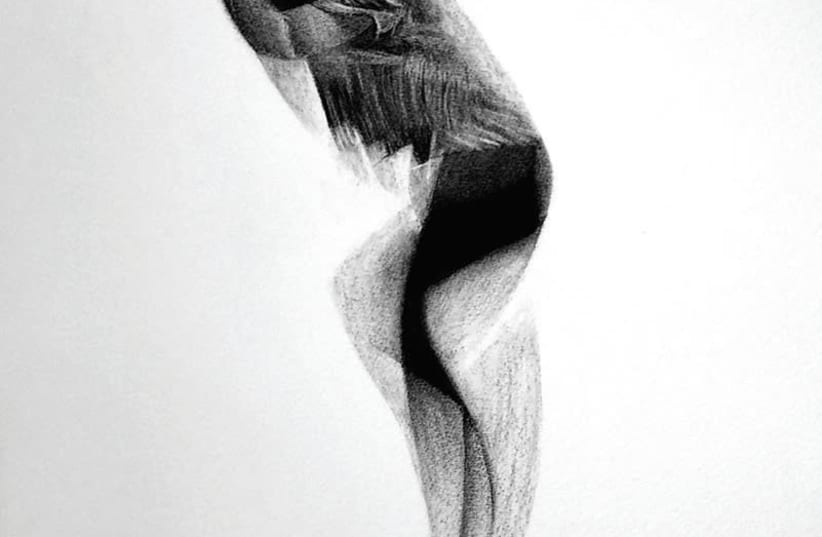As a “modern nomad” as he likes to refer to himself, Michael Halak has spent years moving boxes from location to location.
“These boxes are me; they are my identity, my memories, what is important to me,” he explains over coffee in Tel Aviv. “In the end, these boxes marked ‘Personal Items’ define who I am.”
Halak is sitting beside colleague and former student Samah Shihadi. The two made their way down to Tel Aviv from Haifa, where they both currently live. It is a rainy morning, and Habima Square is filling up with laptoptoting individuals.
In their joint exhibition “Motion Trap,” which is currently on display at Idris, the newly opened, artist-run gallery, Shihadi and Halak relate to the theme of movement from very different perspectives.
The exhibition came together when Idris founders Barak Rubin and Livia Tagliacozzo approached Shihadi.
“They asked me to invite another artist to show with me, and I reached out to Michael,” says Shihadi.
“I usually work alone, so this was a nice opportunity to do something different. I matched myself to her,” Halak adds.
The exhibition occupies the small but pristine Ben-Yehuda Street gallery. White walls serve as backdrops for Shihadi’s and Halak’s pieces. There is an overall sense of quiet.
One of the three works Halak chose to display features two seemingly cardboard boxes sealed with yellow packing tape.
“Personal Stuff” is scrawled in marker on the exterior.
“This work is about transition, about experience and movement.
The box is meant to be temporary, but I have made it permanent.
Where there would normally be paper, I used wood. I feel it is a visual expression of something very personal to me,” he explains.
This piece marks a first foray into three-dimensional forms for Halak, who is a painter by training and profession.
Where Halak took the temporary into the permanent, Shihadi, also a painter, took a more ephemeral approach. In her black on white drawings, she captures female dancers mid-movement.
“I have been toying with the idea of movement for two or three years now,” she says. “I wanted to look at movement and explore it, to see if I could capture something that complex.”
Shihadi began her experiments together with her sister. The two photographed each other dancing, and then Shihadi etched those impression into paintings. Feeling that her dance skills were not up to par with her vision, she sought out the help of dance students.
“Once I began working with dancers, the idea became very clear. I felt that I could see the exact movements that I had in mind; it was just there,” she says.
For Shihadi, taking these passing instants and trapping them on paper, behind glass, in wooden frames, feels like a perfect parallel to the entrapment of women in her society.
“Dance reflects the blur or loss of identity that I think every woman in our society feels,” she says. “We are here and not here.
Dance gives us freedom and also the lack of it.”
Halak clarifies that the society they are talking about is the patriarchal, traditional, Arab one.
“I am Muslim, he is Christian.
We are both from villages in the north of Israel. While there is a difference in the approach to art in our communities, there are a lot of similarities in regard to who is kept on the margins,” Shihadi goes on.
For both Shihadi and Halak, a life in the arts was not an obvious choice. While Halak’s family wants to see him settled down with a steady income, Shihadi’s family would be pleased to see her choose a husband and devote herself to the home.
“Each society has its own codes.
If I talk about women in Arab society, they are on the margins. I find myself on the margins as well as an artist,” says Halak.
He even took a foray into the more traditional work realm, spending two years as a bank employee.
“I studied art in Italy. I got married and had a daughter. I had to find a way to make ends meet, so I got a conventional job. After those two years, I felt I was not right with myself, and I went back to art. I still draw on that time in the bank. it taught me a lot about how to market, to price and to make a business of art,” he says.
Shihadi adds that Halak has been her guide where these issues are concerned.
“No one teaches you how to become a professional artist, not in school, not after. I was lucky to have Michael around,” she smiles.
As the conversation goes on, both artists speak of the lack of a sense of community among visual artists. For this reason, they say, initiatives such as that of Idris are much needed.
Last year, both artists were chosen to show work in a number of Arab countries, including Kuwait and Lebanon. Because of their Israeli passports, they were not able to attend their own exhibitions, a very acute example of the “motion trap” they deal with in their art.
“We are separate from the rest of the Arab world. I am not sure if there are a lot of collaborations between artists from the Arab sector within Israel. We are certainly different than other artists living in Ramallah or Gaza.
Everyone is dealing with identity, but as Palestinians who don’t experience the occupation on a first-hand level; we have an opportunity to look at things from a difference perspective,” she says.
“To be an artist,” says Halak, “you have to free your mind. You have to think beyond the point that you are currently at. I think that every person around the world can relate to my work. They don’t need to know my personal story. That’s the challenge and the beauty of art.”
‘Motion Trap’ is on display through February 11 at the Idris gallery in Tel Aviv.For more information, visit www.idris.space.
